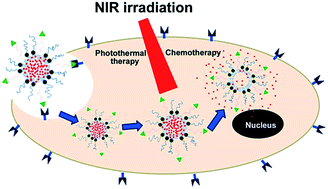Folic acid-conjugated hollow mesoporous silica/CuS nanocomposites as a difunctional nanoplatform for targeted chemo-photothermal therapy of cancer cells†
Abstract
In this work, we have developed a novel difunctional nanoplatform for targeted chemo-photothermal therapy. It is based on hollow mesoporous silica nanospheres as a carrier for anticancer drug-loading CuS nanoparticles attached on a silica nanosphere surface as a photothermal agent, and folic acid (FA) conjugated with a silica nanosphere as a cancer cell target. The nanoplatform has demonstrated a good photothermal effect and excellent doxorubicin (DOX) loading capacity (as high as 49.3 wt%). The photothermal agent and DOX can be targeted to deliver into cancer cells via a receptor mediated endocytosis pathway. Moreover, the release of DOX from the hollow mesoporous silica nanospheres can be triggered by pH and NIR light. Both chemotherapy and photothermal therapy can be simultaneously driven by irradiation with a 980 nm laser. More importantly, the combination of chemotherapy and photothermal therapy shows a better therapy effect than the individual therapies, thus demonstrating a synergistic action.


 Please wait while we load your content...
Please wait while we load your content...